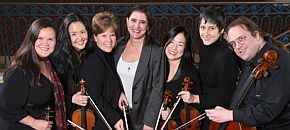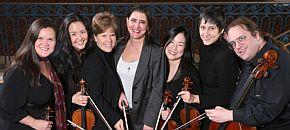
Britten composed the Serenade for his muse and life partner, the tenor Peter Pears, and horn virtuoso Dennis Brain. Thorsett brings a rare combination of virtues to the work: a strikingly beautiful lyric tenor voice and the kind of musical intelligence that was characteristic of Pears’ singing. Thorsett matches that sheer beauty of tone with good diction, vivid use of the text, excellent breath control, and sterling dynamic control — all crucial to the success of the Serenade. In the “Pastoral,” for example, he sang just a bit behind the orchestra at the words “scarce lug the chariot” in the phrase “And yet his steeds, with all his skill/Scarce lug the chariot down the hill.” In the “Nocturne,” he starkly contrasted his tone and volume at the repetitions of “Blow, bugle, blow” with the repeated phrase “Answer, echoes, dying, dying ... dying.” And he found the necessary agility for the “Hymn.”
Rivard matched Thorsett in all this variety and beauty, and brought to the difficult horn part sovereign confidence and virtuosity. He gave the opening “Prologue” for solo horn a riveting and subtle performance, both powerful and nostalgic, equaled at the end of the performance in its offstage recollection, the “Epilogue.” The “Pastoral” emerged, as it should, as a call-and-response between the tenor and the horn. His tone in the eerie “Dirge” could have been the sound of the last trumpet.
You can’t play an encore after a work like the Serenade, but how I would have loved to hear the “Dirge” a second time, for the way the strings, marvelous throughout the piece, built the shape of the piece and the varying accompaniment underlying the repeated tenor phrases.
Building From Strength to Strength
Dvořák’s Serenade is typical of his larger works, combining almost-folklike melodies that are far more sophisticated than you might think, with flashes of Beethovenian power in the last movement. The Waltz is surely the most familiar and most frequently excerpted movement, with its wistful main theme and marchlike second theme. The work highlights all of NCCO’s great strengths: their ability to sound like a much larger group than they actually are, their ability to play with one voice, the gossamer tone in soft sections.For the curtain-raiser and program-closer, NCCO programmed a pair of crowd-pleasers, Hugo Wolf’s Italian Serenade and Béla Bartók’s Romanian Dances. The Wolf, like its older and longer cousin, Mendelssohn’s “Italian” Symphony, is very much a German’s idea of what Italy is like, all dancing 6/8 meter and charm, with brief turns from sunny major to an only slightly darker minor. In contrast, Bartók is, by turns, fierce and plaintive, altogether more emotionally complex. NCCO played the Wolf with propulsive spirit and elegance, the Bartók with passion and great rhythmic vitality. And a special nod goes to principal violist Anna Kruger and acting principal cello Michelle Djokic, for their plangent solos in the Bartók.
You can hear the Bartók on NCCO’s excellent recent CD, Together, which also features works by Clarice Assad, Astor Piazzolla, and George Gershwin. Given the superb performance of the Britten on the current program, and the microphones in evidence at the Berkeley concert, I hope that a forthcoming NCCO recording will feature the Britten.

